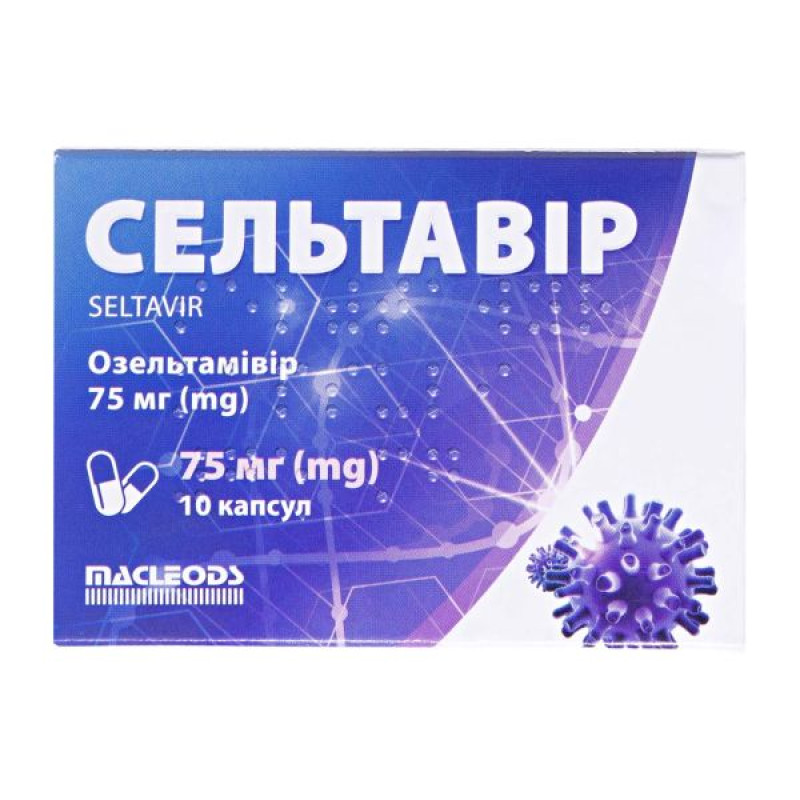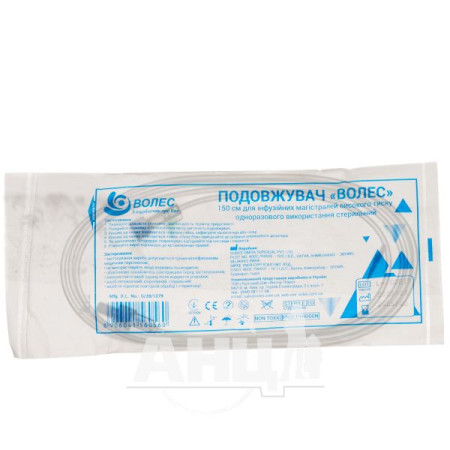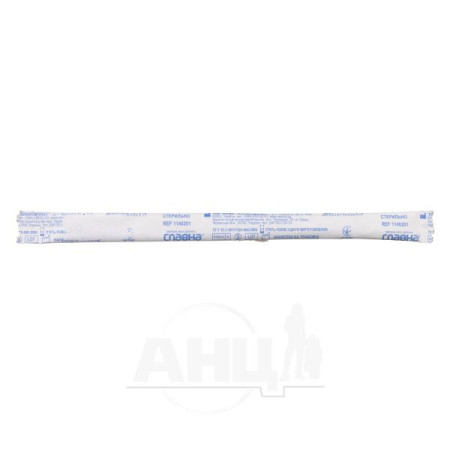Seltavir hard capsules 75 mg blister No. 10

Instructions Seltavir hard capsules 75 mg blister No. 10
Composition
active ingredient: oseltamivir;
1 hard capsule contains oseltamivir phosphate equivalent to oseltamivir 30 mg;
excipients: pregelatinized starch, talc, povidone, croscarmellose sodium, sodium stearyl fumarate, hard gelatin capsule No. 4;
capsule composition: red iron oxide (E 172), yellow iron oxide (E 172), titanium dioxide (E 171), gelatin, purified water;
1 hard capsule contains oseltamivir phosphate equivalent to oseltamivir 45 mg;
excipients: pregelatinized starch, talc, povidone, croscarmellose sodium, sodium stearyl fumarate, hard gelatin capsule No. 4;
capsule composition: black iron oxide (E 172), titanium dioxide (E 171), gelatin, purified water;
1 hard capsule contains oseltamivir phosphate equivalent to oseltamivir 75 mg;
excipients: pregelatinized starch, talc, povidone, croscarmellose sodium, sodium stearyl fumarate, hard gelatin capsule No. 2;
capsule composition: red iron oxide (E 172), yellow iron oxide (E 172), black iron oxide (E 172), titanium dioxide (E 171), gelatin, purified water.
Dosage form
The capsules are hard.
Main physicochemical properties:
30 mg: hard gelatin capsules No. 4 with a light yellow cap and body, marked in blue with “30 mg” on the cap and “M 53” on the body, containing white to almost white granules;
45 mg: hard gelatin capsules No. 4 with a gray cap and body, marked in blue with “45 mg” on the cap and “M 54” on the body, containing white to almost white granules;
75 mg: hard gelatin capsules No. 2 with a light yellow cap and a gray body, marked in blue with “75 mg” on the cap and “M 55” on the body, containing white to off-white granules.
Pharmacotherapeutic group
Antivirals for systemic use. Direct-acting antivirals. Neuraminidase inhibitors. Oseltamivir. ATC code J05A H02.
Pharmacological properties
Pharmacodynamics.
Oseltamivir phosphate is a prodrug of the active metabolite (oseltamivir carboxylate), which selectively inhibits influenza virus neuraminidase, an enzyme that catalyzes the process of releasing newly formed viral particles from infected cells, their penetration into uninfected cells, and the subsequent spread of the virus in the body.
Oseltamivir carboxylate inhibits neuraminidase of influenza A and B viruses in vitro. Oseltamivir phosphate inhibits viral replication and pathogenicity in vitro. Oseltamivir when administered orally inhibits the replication of influenza A and B viruses and pathogenicity in animal models of influenza infection in vivo at antiviral exposures achieved in humans at a dose of 75 mg twice daily.
The antiviral activity of oseltamivir has been confirmed against influenza A and B viruses in experimental studies in healthy volunteers.
The IC50 values of oseltamivir for the neuraminidase enzyme of clinical isolates of influenza A viruses ranged from 0.1 to 1.3 nM and for influenza B viruses were 2.6 nM. Published data have reported higher IC50 values for influenza B viruses with a median of 8.5 nM.
Pharmacokinetics.
Absorption
After oral administration, oseltamivir phosphate is readily absorbed from the gastrointestinal tract and is extensively converted to the active metabolite (oseltamivir carboxylate) by hepatic esterases. At least 75% of an oral dose reaches the systemic circulation as the active metabolite, and less than 5% as the parent drug. Plasma concentrations of both the prodrug and the active metabolite are dose-proportional and therefore independent of food intake.
Distribution
In humans, the mean volume of distribution of the active metabolite at steady state is approximately 23 L, a volume equivalent to the volume of extracellular body fluid. Because the neuraminidase activity is extracellular, oseltamivir carboxylate reaches all major sites of influenza infection.
The binding of the active metabolite to human plasma proteins is low (approximately 3%).
Metabolism
Oseltamivir phosphate is extensively converted to oseltamivir carboxylate by esterases, which are predominantly found in the liver. Neither oseltamivir phosphate nor the active metabolite are substrates or inhibitors of cytochrome P450 isoenzymes in in vitro studies. No phase 2 conjugates for either compound were detected in vivo.
Breeding
Absorbed oseltamivir is eliminated primarily (> 90%) by conversion to oseltamivir carboxylate, which is not further transformed and is excreted in the urine. In most patients, the maximum plasma concentration of the active metabolite declines with a half-life of 6–10 hours. The active metabolite is excreted entirely by the kidneys. Renal clearance (18.8 l/h) exceeds glomerular filtration rate (7.5 l/h), indicating that the drug is also excreted by tubular secretion. Less than 20% of the administered radiolabeled drug is excreted in the feces.
Pharmacokinetics in special groups.
The pharmacokinetics of oseltamivir have been studied in children aged 1 to 16 years in a single-dose pharmacokinetic study. Multiple-dose pharmacokinetics have been studied in a small number of children in a clinical efficacy study. In younger children, elimination of the prodrug and active metabolite occurred more rapidly than in adults, resulting in lower exposures on a mg/kg basis. A dose of 2 mg/kg provides the same exposure to oseltamivir carboxylate as that achieved in adults after a single dose of 75 mg (equivalent to approximately 1 mg/kg body weight). The pharmacokinetics of oseltamivir in children and adolescents aged 12 years and older are similar to those in adults.
Elderly patients
In elderly patients (65–78 years), the exposure of the active metabolite at steady state is 25–35% higher than in younger patients (< 65 years) when using similar doses of oseltamivir. The half-life of the drug in elderly patients is not significantly different from that in younger patients. Based on drug exposure and tolerability, no dose adjustment is necessary in elderly patients, except in patients with moderate or severe renal impairment (creatinine clearance < 60 ml/min) (see section "Method of administration and dosage").
Patients with kidney damage
Administration of oseltamivir phosphate 100 mg twice daily for 5 days in patients with varying degrees of renal impairment demonstrated that oseltamivir carboxylate exposure is inversely proportional to the decrease in renal function. For dosage, see section 4.2.
Patients with liver damage
Based on in vitro studies, neither a significant increase in oseltamivir exposure nor a significant decrease in the exposure of the active metabolite of oseltamivir is expected in patients with hepatic impairment (see section 4.2).
Pregnant women
A pooled population pharmacokinetic analysis indicates that the dosing regimen described in the Dosage and Administration section results in lower exposure (on average 30% across all trimesters) of the active metabolite in pregnant women compared to non-pregnant women. However, the predicted lower exposure remains above the inhibitory concentrations (IC95 values) and therapeutic influenza strain ranges. In addition, observational data suggest a benefit of the current dosing regimen in this patient population. Therefore, no dose adjustment is recommended for pregnant women for the treatment or prevention of influenza (see Use during pregnancy and lactation).
Indication
Flu treatment
The drug is indicated for adults and children aged 1 year and older who have symptoms of influenza during the period of influenza virus circulation. Efficacy has been demonstrated when treatment is initiated within 2 days of the first onset of symptoms.
Flu prevention
- prevention of influenza in adults and children aged 1 year and older after contact with a person with clinically diagnosed influenza during influenza virus circulation;
- the appropriate use of the drug for the prevention of influenza should be determined on a case-by-case basis, taking into account the circumstances and the patient population requiring protection. In exceptional situations (e.g. in case of discrepancies between the circulating influenza virus and the influenza virus against which vaccination was carried out and during a pandemic), seasonal prophylaxis can be carried out in persons aged 1 year and older.
The use of the drug does not replace vaccination against influenza.
The use of antivirals for the treatment and prevention of influenza should be based on official recommendations. The decision to use oseltamivir for treatment and prevention should take into account the characteristics of circulating influenza viruses, available information on the susceptibility of influenza viruses to drugs in each season, the impact of the disease in different geographical regions and patient groups.
Contraindication
Hypersensitivity to oseltamivir phosphate or to any component of the drug.
Interaction with other medicinal products and other types of interactions
The pharmacokinetic properties of oseltamivir, such as low protein binding and metabolism independent of CYP450 and glucuronidase systems (see section 5.2), suggest that clinically significant interactions with other medicinal products are unlikely.
Probenecid
No dose adjustment is required when oseltamivir and probenecid are co-administered in patients with normal renal function. Concomitant administration of probenecid, a potent inhibitor of the anion pathway of renal tubular secretion, approximately doubles the exposure to the active metabolite of oseltamivir.
Amoxicillin
Oseltamivir does not show a kinetic interaction with amoxicillin, which is eliminated by the same pathway as oseltamivir, indicating a weak interaction with oseltamivir via this pathway.
Clinically significant interactions with other drugs involving competition for renal tubular secretion are unlikely due to the known safety margins of most of these drugs, the elimination characteristics of the active metabolites (glomerular filtration and anionic tubular secretion), and the volume of excretion by these routes. However, caution should be exercised when prescribing oseltamivir to patients taking drugs with a similar excretion pathway and a narrow therapeutic index (e.g., chlorpropamide, methotrexate, phenylbutazone).
Additional information
Pharmacokinetic interactions between oseltamivir and its active metabolite when co-administered with paracetamol, acetylsalicylic acid, cimetidine and antacids (magnesium hydroxide and aluminum hydroxide, calcium carbonate), rimantadine or warfarin (in patients on stable doses of warfarin and not sick with influenza) have not been identified.
In phase III clinical trials of oseltamivir for the treatment and prevention of influenza, the drug was administered with commonly used drugs, such as ACE inhibitors (enalapril, captopril), thiazide diuretics (bendrofluazide), antibiotics (penicillin, cephalosporin, azithromycin, erythromycin and doxycycline), H2-receptor blockers (ranitidine, cimetidine), beta-blockers (propranolol), xanthines (theophylline), sympathomimetics (pseudoephedrine), opioids (codeine), corticosteroids, inhaled bronchodilators, analgesics (acetylsalicylic acid, ibuprofen and paracetamol). When Seltavir was used together with the listed drugs, no changes in the safety profile and frequency of adverse reactions were recorded.
There is no mechanism of interaction with oral contraceptives.
Application features
Oseltamivir is effective only against diseases caused by influenza viruses. There are no data on the effectiveness of oseltamivir in any diseases caused by pathogens other than influenza viruses.
The use of the drug does not replace vaccination against influenza. The use of the drug should not affect the screening of individuals for annual vaccination against influenza. Protection against influenza lasts only while taking the drug. Seltavir should be used for the treatment and prevention of influenza only when there is reliable epidemiological data indicating the circulation of the virus. It has been demonstrated that the susceptibility of circulating strains of influenza virus to the drug is highly variable, so the doctor should take into account the latest information on the susceptibility of currently circulating viruses to oseltamivir before making a decision on the use of the drug.
Severe skin reactions and hypersensitivity reactions
During post-marketing use, cases of anaphylaxis and severe skin reactions, including toxic epidermal necrolysis, Stevens-Johnson syndrome, and erythema multiforme, have been reported. Seltavir should be discontinued and appropriate treatment instituted if such reactions are observed or suspected.
Severe comorbidities
There is no information on the safety and efficacy of oseltamivir in patients with severe or unstable illness at imminent risk of hospitalization.
Immunocompromised patients
The safety and efficacy of oseltamivir for the treatment and prevention of influenza in immunocompromised patients have not been established.
Heart/respiratory disease
The efficacy of oseltamivir in the treatment of individuals with chronic heart and/or respiratory disease has not been established. In such patients, no difference in the incidence of complications was observed between the treatment and placebo groups.
Severe renal failure
Dose adjustment of the drug for treatment and prophylaxis is recommended for adults and adolescents (≥13 - <18 years) with severe renal impairment. There are insufficient clinical data on the use of the drug in children aged 1 year and older with renal impairment to make dosage recommendations (see sections "Pharmacokinetics", "Method of administration and dosage").
Neuropsychiatric disorders
Cases of neuropsychiatric disorders have been reported in influenza patients (mainly children and adolescents) using the drug. Such disorders have also been reported in influenza patients who did not use the drug. Patients should be closely monitored for behavioral changes, and the benefits and risks of continued treatment should be carefully assessed for each patient (see section "Adverse reactions").
Disposal of unused and expired medicinal products. Release of medicinal products into the environment should be minimised. The medicinal product should not be disposed of in wastewater or household waste. For disposal, a so-called waste collection system should be used (if available).
Use during pregnancy or breastfeeding
Pregnancy
The data obtained and the results of animal studies indicate no direct or indirect harmful effects on the course of pregnancy, embryonal/fetal development and postnatal development. Pregnant women can use the drug taking into account the available safety information, the pathogenicity of the circulating influenza virus strain and the condition of the pregnant woman after assessing the benefit/risk ratio.
Breastfeeding period
In lactating rats, oseltamivir and its active metabolite are excreted in human milk. There is limited information on breastfeeding in women taking oseltamivir and on the excretion of oseltamivir in human milk. Limited data demonstrate that oseltamivir and its active metabolite have been detected in human milk, but their levels were low, which may result in subtherapeutic doses to the infant. Given these data, as well as the pathogenicity of the circulating influenza virus strain and the condition of the nursing woman, the use of oseltamivir may be considered after assessing the benefit/risk ratio.
Fertility
Based on preclinical data, there is no evidence of an effect of the drug on male or female fertility.
Ability to influence reaction speed when driving vehicles or other mechanisms
No effect.
Method of administration and doses
Method of application
For oral use.
Dosage
The drug at a dose of 75 mg can be used as:
– 1 capsule of 75 mg or
– 1 capsule of 30 mg and plus one capsule of 45 mg.
Adults and adolescents aged 13 and over
Treatment. The recommended dosage regimen of the drug is 1 capsule of 75 mg 2 times a day orally for 5 days for adults and adolescents (≥13 - <18 years) with a body weight of more than 40 kg.
Treatment should be started on the first or second day of flu symptoms.
Post-exposure prophylaxis. The recommended dose for post-exposure prophylaxis is 75 mg orally once daily for 10 days for adults and adolescents (≥13–<18 years) weighing more than 40 kg. The drug should be started no later than 2 days after exposure.
Prevention during seasonal influenza epidemics. The recommended dose for prevention during seasonal influenza epidemics is 75 mg once a day for 6 weeks.
Children aged ≥1 – <13 years.
Treatment. Recommended dosage regimen with weight adjustment for the treatment of infants and children aged 1 year and older
| Body weight | Recommended dose for 5 days |
| From 10 kg to 15 kg | 30 mg 2 times a day |
| > 15 kg to 23 kg | 45 mg 2 times a day |
| > 23 kg to 40 kg | 60 mg 2 times a day |
| > 40 kg | 75 mg 2 times a day |
Treatment should be started as soon as possible, on the first or second day of flu symptoms.
Post-exposure prophylaxis. Recommended dosage regimen
| Body weight | Recommended dose for 10 days |
| From 10 kg to 15 kg | 30 mg once daily |
| > 15 kg to 23 kg | 45 mg once daily |
| > 23 kg to 40 kg | 60 mg once daily |
| > 40 kg | 75 mg once daily |
Prevention during seasonal influenza epidemics. Prevention during seasonal influenza epidemics in children under 12 years of age has not been studied.
Dosage in special cases
Patients with liver dysfunction
No dose adjustment is necessary for treatment or prophylaxis in patients with hepatic impairment. The safety and pharmacokinetics of oseltamivir have not been studied in children with hepatic impairment.
Patients with renal impairment
Treatment of influenza: Dose adjustment is required in adults and adolescents (≥13 - <18 years) with moderate or severe renal impairment (see Table 1).
Table 1
| Creatinine clearance | Recommended dose for treatment |
| > 60 ml/min | 75 mg 2 times a day |
| > 30 to 60 ml/min | 30 mg 2 times a day |
| > 10 to 30 ml/min | 30 mg once daily |
| ≤ 10 ml/min | not recommended (data not available) |
| patients on hemodialysis | 30 mg after each hemodialysis session |
| patients on peritoneal dialysis* | 30 mg once |
* Data from studies in patients on continuous ambulatory peritoneal dialysis (CAPD); clearance of oseltamivir carboxylate is expected to be higher when using automated continuous cyclic peritoneal dialysis (CCPD). The treatment regimen may be changed from CCPD to CAPD if deemed necessary by the nephrologist.
Influenza prophylaxis: Dose adjustment is required for adults and adolescents (≥13 - <18 years) with moderate or severe renal impairment (see Table 2).
Table 2
| Creatinine clearance | Recommended dose for prevention |
| > 60 ml/min | 75 mg once daily |
| > 30 to 60 ml/min | 30 mg once daily |
| > 10 to 30 ml/min | 30 mg every other day |
| ≤ 10 ml/min | not recommended (data not available) |
| patients on hemodialysis | 30 mg after every second hemodialysis session |
| patients on peritoneal dialysis* | 30 mg once a week |











